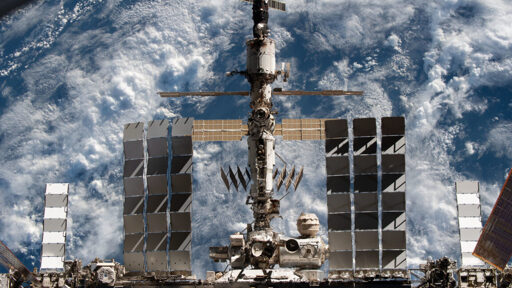The transfer tunnel, known by the Russian acronym PrK, connects the Zvezda module with a docking port where Soyuz crew and Progress resupply spacecraft attach to the station.
Air has been leaking from the transfer tunnel since September 2019. On several occasions, Russian cosmonauts have repaired the cracks and temporarily reduced the leak rate. In February, the leak rate jumped up again to 2.4 pounds per day, then increased to 3.7 pounds per day in April.
“The Russian position is that the most probable cause of the PrK cracks is high cyclic fatigue caused by micro-vibrations,” Cabana said on November 13. “NASA believes the PrK cracks are likely multi-causal, including pressure and mechanical stress, residual stress, material properties, and environmental exposures.”
Crew members aboard the space station are keeping the hatch leading to the PrK closed when they don’t need to access the Progress cargo freighter docked at the other end of the transfer tunnel. Russian cosmonauts must open the hatch to unpack supplies from the Progress or load trash into the ship for disposal.
As a precaution, Barratt said space station crews are also closing the hatch separating the US and Russian sections of the space station when cosmonauts are working in the PrK.
“The ISS is leaking?? Where?”
“It’s high overhead, orbiting the earth at tremendous speed. But that’s not important right now.”
Airplane?
No, space station
I just wanted to say good luck, and we’re all counting on you.
Surely?
Yes, it is a space station, and don’t call me Shirley.
Airplane!
Fill the ISS with water and you’ll be able to see the leak.
This is probably the dumbest thing I’ve heard. You clearly have no idea what you’re taking about. To find the leak they need to spray the outside with soapy water. If that doesn’t work the next step is to put the ISS in a bathtub and fill the bathtub with water
Idiot. You obviously have no idea about the logistics of launching a bath into space. You’d need to send a bucket on a rocket (aero dynamic).
Put the ISS into the bucket, fill with water, then squeeze the ISS and look for bubbles.
Fucking fools. Just use a robotic arm to bend the whole suspect section. You’ll see the cracks open up as you flex it back and forth, and can spray some flex seal in the cracks. Seriously, try a little bit.
Brainless hemroids! Shmear the conspicuous gelatinous substance from front to back, always from front to back. Freshen & powder, and wrap her back up before she starts spewing like a little lad.
Great now there’s an 1800’s sailor on the space station.
I’m gonna show you ninnies how to really skip this boat
deleted by creator
You all are fools, all this time finding the leak and none of you brought the tire patch
Clearly you’re thinking with your feet, because if you used your brain you’d know you bring the ISS to the bathtub, not the other way around
Ah, so after the ISS deorbit vehicle dunks it in the South Pacific, we can patch the hole and put it on the ISS reorbit vehicle. Right?
You’re all fools.
All you need to do is shield the exterior of the section, seal, depressurize, and bring to room temperature, then fill sufficiently with the soapy water.
They need two halves of a large enough tube with a valve in one of them, and something to interface between the ISS and the addition.
Just cover the exterior with soapy water
“ISS! More like H-ISS! amirite?!”
The lack of an H is part of the French contribution to the station.
It’s not a leak, it’s a leaqu’est
They just need to get their hands on HRAs to keep the hiss at bay. Where’s Dr. Darling??
Out there looking like dynanite
Because there’s a hole in it, stupid.
That’ll be five million dollar bucks for my consultation.
Line-item breakdown:
Fix-a-flat, $5.
Knowing where to squirt, $4,999,995.
Teenage me could have figured that out in a couple days, if you fire enough bullets eventually you’ve got to hit the target.
I’m a little surprised they don’t have, like, million-dollar lint, so it’ll tend toward the outflow points and clog them.
Ah, you mean G-lint, we make it from gold flecks because fuck you, oh and it keeps costs high and corrosiveness low.
Nonreactive, nonmagnetic, high-density, and preeetty.
✨ it’s Fabulous ✨
But the hole is on the Russian side and the Russian side is absolutely perfect. No holes here, Comrade, breathing is a luxury some people do not get. Do not become one of those non-breathers Comrade.
The ISS has been leaking air for 5 years, and engineers still don’t know why
*raises hand*
Uh, is it the cold unforgiving vacuum of space that forbids our existence there?
Space doesn’t really have a temperature as you need something to be hot or cold! And in the vacuum there isn’t much.
So just unforgiving vacuum.
My brain just imploded from that realisation and it troubles me.
I can intellectually reconcile what you said, but my reptilian brain cannot comprehend the phenomenon for whatever reason.
I instinctively don’t believe that the radiation only is how heat is transferred in the vacuum even though I know that this the case. We always have had 3 (convection, conduction and radiation), and that stumps me.
Heat transfer by radiation complicates things. We lose the majority of our heat that way, and we’d lose a lot more if every cubic inch of the spaces we inhabit weren’t flooded with thermal radiation from the objects that surround us.
You can absolutely judge the temperature of a volume, vacuum or not, by its radiation content at any given moment.
You’re describing a thermal balance. Temperature is a property of matter which doesn’t exist in a perfect vacuum. That said, the space around ISS is far from a perfect vacuum (atomic oxygen sucks). In any case, the typical temperature model starts to breakdown with increasing vacuum.
Sure, but in any practical sense it is a temperature. It would be silly to say space isn’t cold (or hot depending) from a regular person’s perspective. Thermal balance creates an effective temperature, even if it wouldn’t be described as a temperature within some technical frame of reference.
That’s a fair point.
It’s not cold physically, it’s cold emotionally.
If you really play with definitions you can equate cold to things that are thermal insulators and hot to things that are conductors. By that (very stretched) definition a vacuum is cold. Perfectly cold.
The stretching: Even if something is like a thousand degrees but it’s a near perfect thermal insulator, it won’t feel that hot when you touch it.
Sounds like earth now that you describe it.
Because it’s a slapped-together mess of duct tape and hope?
The ISS is old. It was never meant to last past 2013. At this point, minor malfunctions, like this are expected.
The ISS needs to be replaced with a larger orbital research platform.
The question is how much would it cost to build such? I believe the International Space Station itself cost like $100 billion to build, which is a lot of money. Now, maybe Space Station construction costs have dropped in the like 20 years, or something like that, since then.
$100 billion sounds a lot, but in comparison it’s miniscule. For that amount of money you can either run an international space station for 24 years or the US military for 1.3 months, or the russian military for one year. If we’d just start killing eachother a little less, we could easily save that much money.
I am all for killing less people and funding space stations. That’s for sure.
I would assume inflation made the number bigger today even if costs have dropped.
Well, apparently it cost a hundred billion to actually build the thing and that was in like dollars in 2000. So you’d have to hope that space station development went down faster than inflation went up. And if so, it might actually cost a little bit less to build it today.
Right now? Effectively infinity dollars. Or Euros. Or Dongs. Regardless of the currency used, really. The only operational launch vehicles that have the diameter and payload capabilities to put up modules of comparable size are the SLS and Vulcan Centaur. Everything else comes up short in size, payload, or both. But getting the modules up there is only step 1, they also need to be attached. For the ISS, the Shuttle’s Canadarm was used to actually assemble the station in its early stages. Nothing currently operational has that capability.
Of upcoming launch vehicles, New Glenn and Starship are both capable enough in both size and payload. But of all the options, only Starship could be equipped with something like Canadarm. Starship is an orbiter with a payload bay. Everything else’s second stage is just engines, tanks and a payload adapter for simply deploying something into orbit.
You might ask “Why not design the modules to dock and assemble the station autonomously?” It’s a valid question, but it comes down to two things: complexity and mass. Every module would need its own full suite of guidance and control systems. And they’d be used only when a module is maneuvering to meet with the rest of the station. That’s a lot of mass wasted on something that only gets used once, mass that could’ve been put into making the module itself bigger. There’s also the issue of any leftover propellants and their residues on the module exteriors. It’s practically inevitable that some residue from the thrusters will end up on the connecting surfaces of the modules. A lot of the common orbital maneuvering propellants are toxic as fyuck and you don’t want any of it near unprotected people. And any residue could interfere with getting a firm seal between modules.
Another thought is to put something like Canadarm on the first module, but that also wouldn’t really work. Soon as it tries to move a second module into position, the two nearly equivalent mass objects would start tumbling around the common center of gravity, putting the entire proto-station into an uncontrolled spin on several axes. Stopping it would require, once again, thrusters.
Yeah, you make a very good point, and at least to my knowledge, the private space stations that are being talked about are only one module. I think there was a proposal for a multiple module station. But it would suffer the same issues that you are talking about with having to have guidance on each module and possibly having propellant on the outer surface. As you mentioned above,
No it needs to be expanded so that it can house thousands of different species.
The ISS is modular
It needs a new module. Undo the tinker toys and put them back together.
The ISS is modular
Undo the tinker toys
Cold welding has entered the chat. The ISS might not be modular… any more.
Someone needs to close the damn window, we aren’t paying to heat the entire universe
It’s the I-SSsssssssssssssssssss
Have they tried lighting a match and following the smoke?
Hot box the ISS! We need to train stoners to be astronauts so the can come save the day!
Cheesy Aerosmith music intensifies
Question: When Air leaks from the ISS, does it just orbit with it indefinitely as an “air bubble” or maybe a dispersed “air cloud” around it or will it eventually settle down into the atmosphere?
In a vacuum, gas will expand indefinitely, so they probably become stray atoms of gas, that will orbit for a little, ocassionallt hitting each other and probably eventually falling back in the atmosphere.
It’d be freakier if it was taking on air.
NASA: None of our engineerscan solve this problem.
HVAC guy: Hmm, can’t use soap bubbles in space… maybe if they use some smoke to make the leak visible…
Hilariously water with dye is almost certainly how they’re detecting the leaks position since most of the fun tracer gases are oxygen replacers or straight up toxic.
The only reason to use gases for this on earth is because liquids are too heavy to be sucked towards to small leaks. In space, isn’t there a case to be made to use some small light solids? Not styrofoam because theyre staticky. But if you found something of equivalent density that would float towards the leaks, but didn’t pick up static and could easily be cleaned out of the air filters…it would be useful for this.
High oxygen environment and almost anything in a powder is extremely explosive including plastic and for that matter baking soda. Some things that aren’t even flammable are potentially explosive when powdered, science is weird sometimes.
Plastic yes, baking soda no. What part of baking soda would burn? The molecule is already about as oxidized as it could be.
Shit you’re right I meant flour.
Ah yes, flour can definitely explode if aerosolized.
Restaurant guy: one of your employees probably taking a little smoke break.
Doesn’t that throw off the trajectory over time?
Negligibly, they already lose significant enough altitude from the rare atmosphere up there to need to do boosts, but yes if it is a net force
Probably installed an airopen instead of an airlock.
That’s going to need a lot of flex tape.












